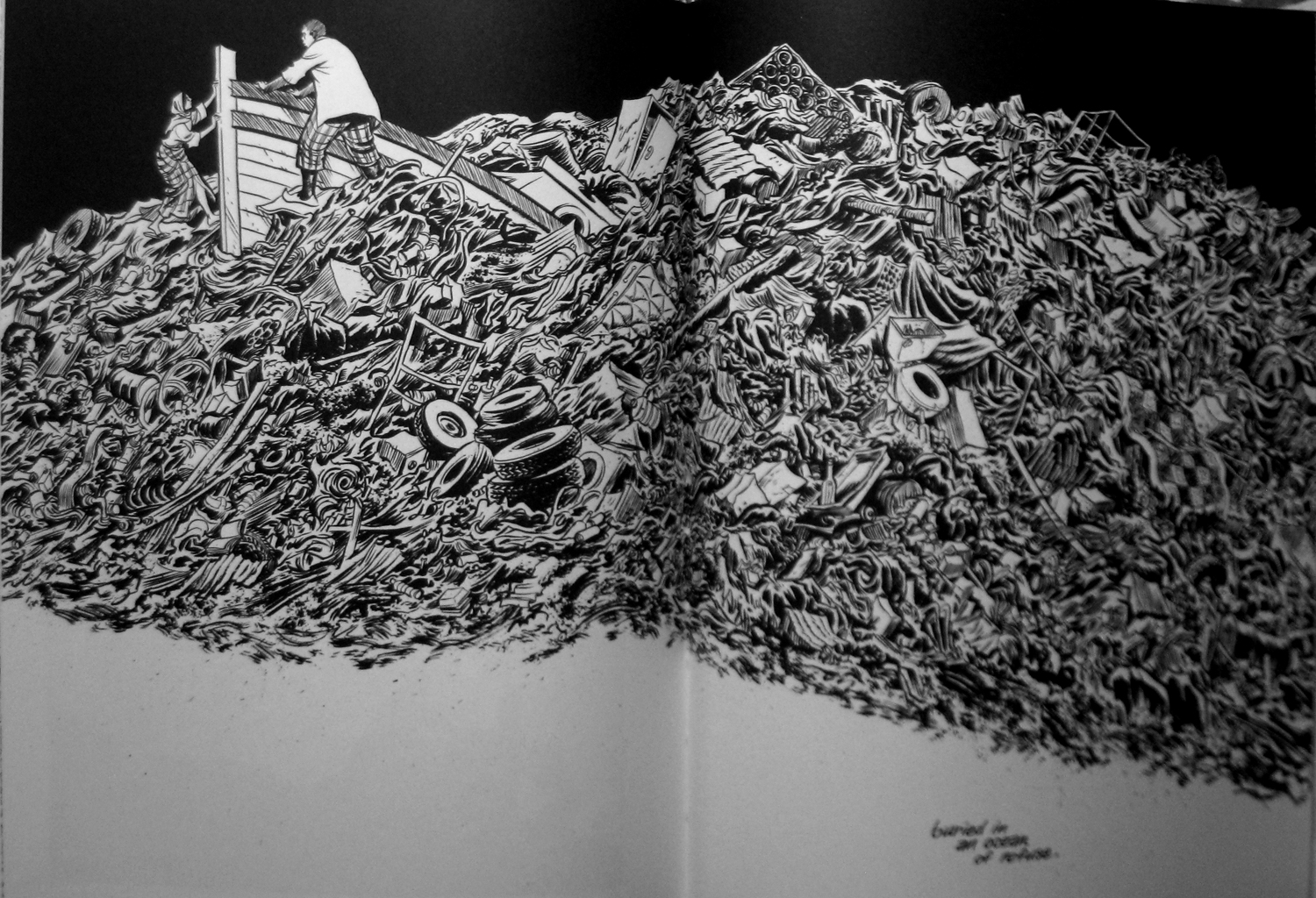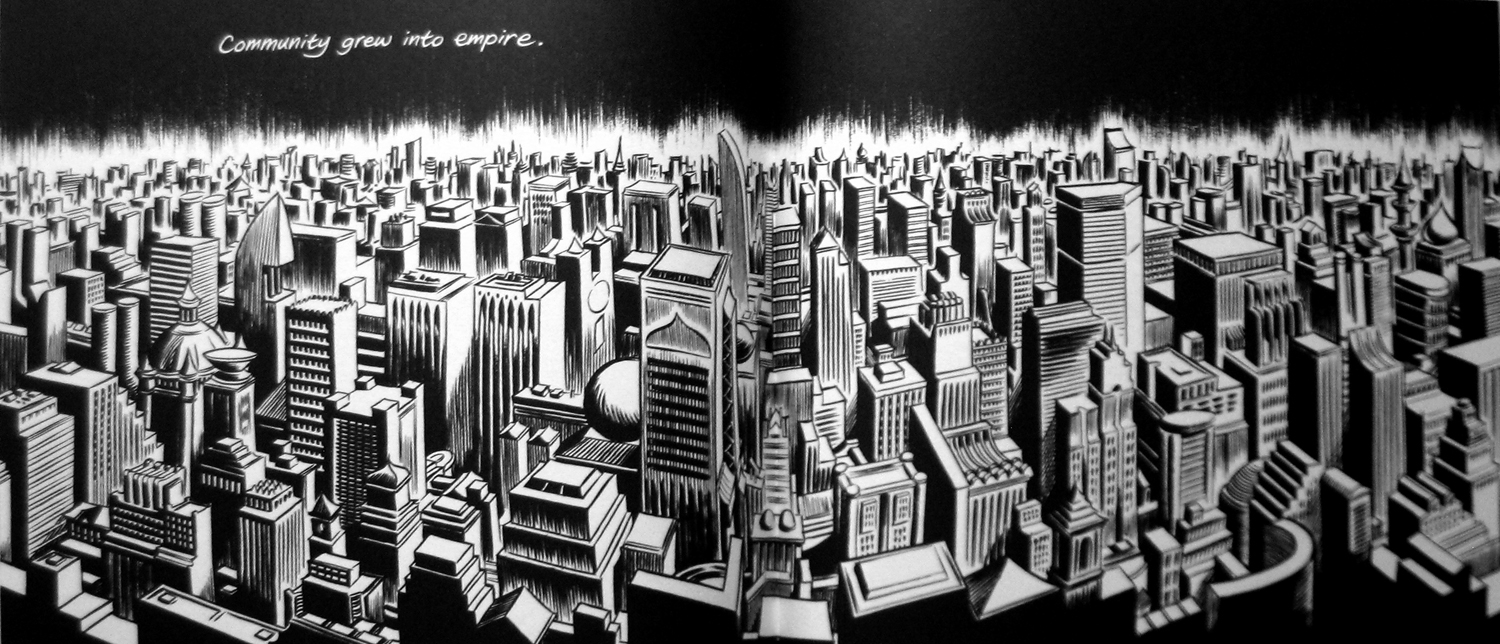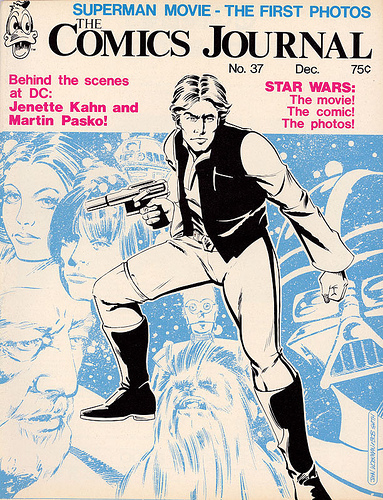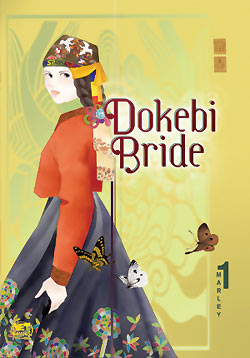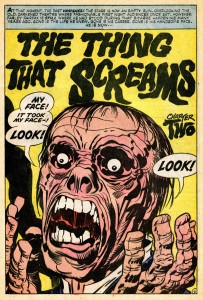
The critical reception of Craig Thompson’s major new book Habibi has been somewhat dismaying. Sometimes, and — I am happy to say — more than occasionally these days, one reads comics criticism of such quality that one is perhaps fooled into believing that the form is finally receiving its due, that we have moved beyond the facile ideological critiques and “story vs. drawing” discussions of yesteryear. But then something like this book comes out and reality bites.
To start with the former issue, parts of the comics intelligentsia seem to be developing an unhealthy obsession with ideological readings of comics. To the extent where a given work is weighed entirely according to an ethical consensus and found wanting because of “problematic” content, most frequently of racist, sexist, or politically offensive nature. Anything else that the work might have to offer tends to be ignored and the notion that something might be good, even great, despite – or even because – of its problems seems inadmissible.
This site has become affected by such thinking in the last year or so to the extent that opening a random article will more likely than not bring the goods. Examples include the endless arguments over Robert Crumb’s racism (in which ‘satire’ has been held up as an inefficacious fig leaf by his defenders), the overblown accusations of sexism directed against Eddie Campbell in our roundtable on his work, the rather one-sided focus on Chester Brown’s choice to depersonalize the prostitutes he depicts in Paying for It, or most recently the discussion of Craig Thompson’s Orientalism in Habibi, which perhaps found its most vicious form in Suat’s review of the book.
I am not necessarily denying that the works in question, or indeed comics history more broadly, are haunted by such issues, nor am I arguing against choosing them as an avenue of criticism — Nadim Damluji’s examination of Habibi is a good example of a considerate approach, while Noah’s obliteration of certain recent DC books offers righteous polemic. The problem, rather, is that such criticism is often informed by a kind of ideological Puritanism that has gained traction in our current culture of taking offense — a Puritanism often blind to aesthetic quality, resistant to uncomfortable discourse, and prone to censorious action.
In the case of Habibi, it seems to me facile and unproductive to harp for too long on its sexism and Orientalism. Yes, it offers both and it suffers from it, but why does that have to be the full story? It is simultaneously, and obviously, a book so generous in intent and so voracious of ambition, that such criticism risks coming off as petty and, more importantly, ends up lacking in resonance.
 Does Habibi successfully realize its sprawling ambition? No, it is a bit of mess, frankly, almost claustrophobic in its efforts to cram meaning into a formal structure unprepared for it. There is a distinct unease in the work between its conceptual and formal concerns, an attempt to stretch intellectually within a cartoon framework driven by stereotype and concerned with stylistic élan.
Does Habibi successfully realize its sprawling ambition? No, it is a bit of mess, frankly, almost claustrophobic in its efforts to cram meaning into a formal structure unprepared for it. There is a distinct unease in the work between its conceptual and formal concerns, an attempt to stretch intellectually within a cartoon framework driven by stereotype and concerned with stylistic élan.
As was the case with Thompson’s paragon Will Eisner when he switched to graphic novel mode in the late seventies, Habibi is marked by an insistence on the value of the archetypes of traditional cartooning as a vehicle for the communication of sophisticated ideas. But where Eisner was suggesting untapped potential, Thompson’s cartooning is retrospective, barely transcending pastiche; where Eisner was concerned with paring down his visual storytelling to eliminate the kind of stylistic excess he had practiced in his classic Spirit strips, Thompson has his cake and wants to eat it too, letting his line run away with the narrative; most importantly however, Eisner’s mature cartooning, for all its faults, is animated by a genuine, mostly unpretentious effort to communicate truthfully, whereas with Thompson, whatever earnestness motivated him, the work smothered in conceptual intent.
Which brings me to the other issue I have with the critical reception of Habibi, and comics in general: the lack of sensitivity to how the visuals are integrally determinant of the work. Critics tend not to look beyond the surface qualities of the drawing in comics, and then proceed to discuss whatever conceptual issues are at stake without devoting much attention to how those issues are manifested visually. Even a cursory examination of the reviews published so far of Habibi should demonstrate this. Only a few have been entirely positive and several have been strongly negative in the conceptual assessment of the book and its ‘writing,’ but the majority of the reviewers have nevertheless taken time to commend the ‘art.’
Despite his strong misgivings, Damluji praises Thompson’s “stunning artwork,” and Fatemeh Fakhraie — while stating that she has no choice but to hate the book — “admits” that it is “beautifully drawn,” but does not engage that part of her experience much further. In their ambivalent takes at the Comics Journal Chris Mautner and Rob Clough both call the cartooning “visually stunning,” while the latter adds “amazingly beautiful” and praises Thompson’s “astonishing” attention to detail; Charles Hatfield, for his part, describes his drawing as “gorgeous” in his equally equivocal assessment in the same place.
In his notes on the book, Sean T. Collins isolates the “art” in one of fifteen bullet points, calling it “lush and lovely on a surface level,” and describing how Thompson’s line “swoops and curves in a fashion he’s explicitly compared to handwriting.” In her critical examination, Tansim Qutait also picks up on this, describing the book as a “…beautifully crafted volume, the ornately decorated pages broadening possibilities for expression in the graphic novel form, as the calligraphy adds an innovative third dimension to the duality of image/text,” without further detailing why or how that would be the case (calligraphy and comics have a long common history). And Michel Faber of The Guardian grandstands against a paper tiger that would have serious comics aesthetes scoff at technical chops, calling the book “an orgy of art for its own sake.”
You cannot argue with taste, but the uniformity of the reaction strikes me as notable. Belying Faber’s theory, comics have generally been and continue to be valued for the technical accomplishment of the art. Thompson is certainly technically accomplished, but these critics seem to overlook that his virtuosity “…is a conventional sort of virtuosity,” here used “in the service of a conventional exoticism,” as Robyn Creswell puts it in his New York Times review of the book. Or as Suat describes it more bluntly, it “…lacks the emotive and stylistic range to capture the pain and suffering he is depicting (almost everything takes on the sensibility of an exercise in virtuosity or an educational diagram).”
Rarely, if ever, does Thompson’s visualizations of his characters support the book’s implicit assertion that it is more than broad melodrama (which it nevertheless is, or could have been, but more on that presently). Wide-eyed Dodola alternates between wonder, despondency, anger, and bliss through the book, as if following Suat’s educational diagram.
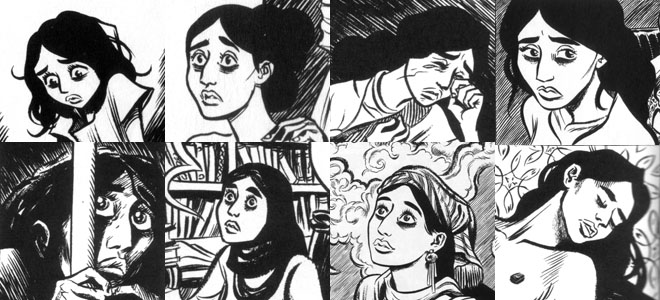
The implied complexity of her emotion as she finally proposes a sexual union with her former charge Zam, after many years of separation, is for example undermined entirely by a banal progression from surprise to pity and doubt that simultaneously overstates and flattens the plea for redemption we are supposed to feel. Doughboy Zam’s evasive maneuvers and flitting baby eyes — supposedly a reckoning after years of denying his sexuality to the extent of self-castration — is not any more persuasive.
Secondary characters fare even worse: as several critics have noted, there is nothing to distinguish the sultan beyond central casting, which makes him hard to care about even as a villain. (This is emphatically not the case with the better of Thompson’s nineteenth-century models in Orientalism: compare for instance Delacroix’ chilling portrayal of the tyrant Sardanapalus). And the characterization of walk-on characters, such as the slaves encountered in the market by the fisherman Noah, is often embarrassingly rote, as if Thompson were not even trying.
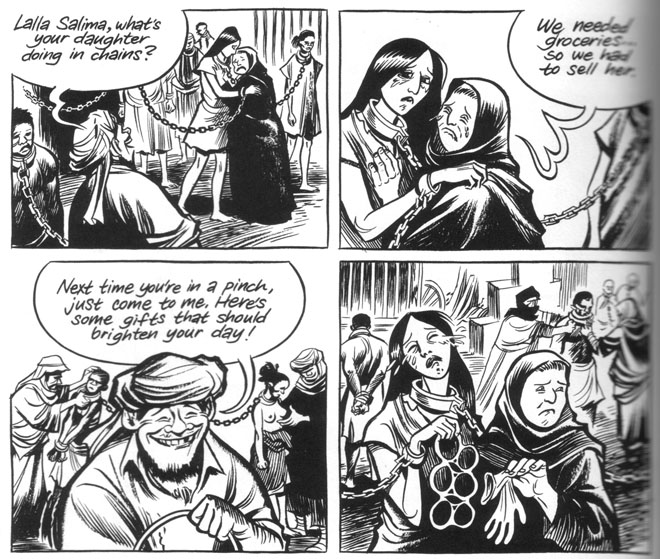
As previously noted, I suppose he is following Eisner here, but his proposition that these stereotypes — the stuff of kitsch illustration — can carry his ambitious attempt at reconciling typology and psychological realism is unconvincing.
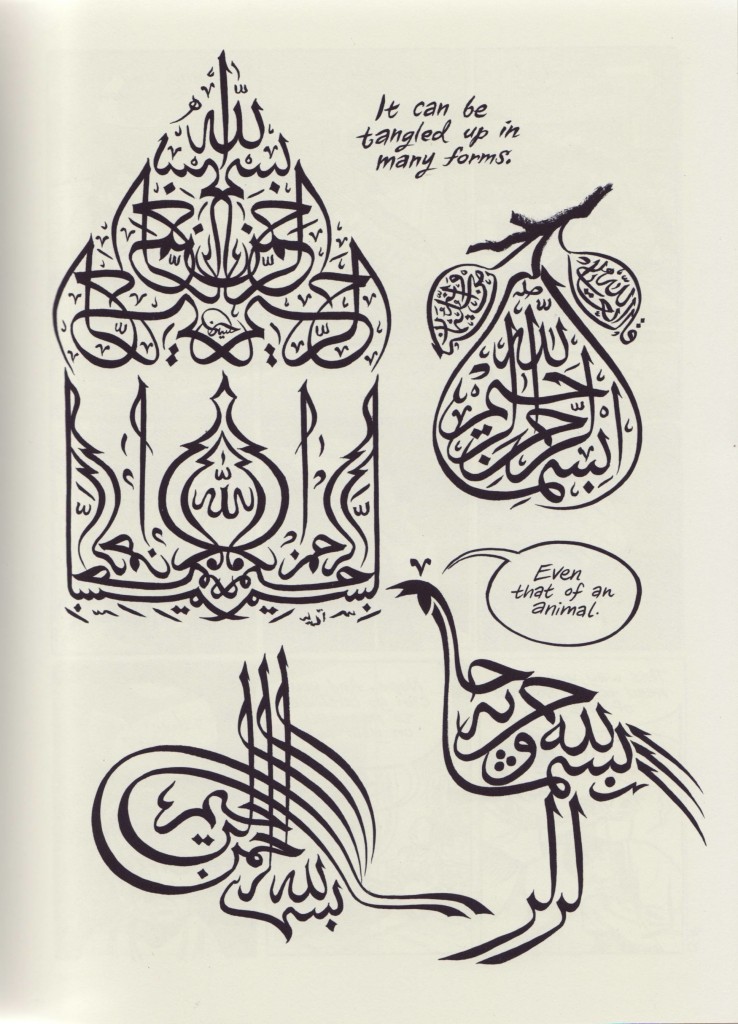
The same goes for his much praised ‘calligraphic’ line. His explication of the word ‘Bismillah’ in the Qu’uran for example is deftly wrought, but his examples sit uncomfortably on the page, one diagram after the next, rather than being woven together harmoniously the way one encounters in good calligraphy. And the line is rather mechanical, incapable of surprising us – every stroke is in its place, and we know where it is headed. Compare Thompson’s other great paragon, Blutch, who for all his faults invariably retains a spontaneity of rendering, a reflexive laxity of control that enables surprise error and insight.
If this comparison with one of the masters seems unfair, one need look no further than a considerably less facile cartoonist than Thompson, who also just published a big book of comics (Big Questions): Anders Nilsen. Though less secure, often laborious, and marked by errors, his line moves with a nervous jumpiness that makes us wonder what meaning it holds, where it is going.
Thompson’s range, similarly, is limited. He uses the same lines to delineate the curve of a sand dune and bodily effluvium.
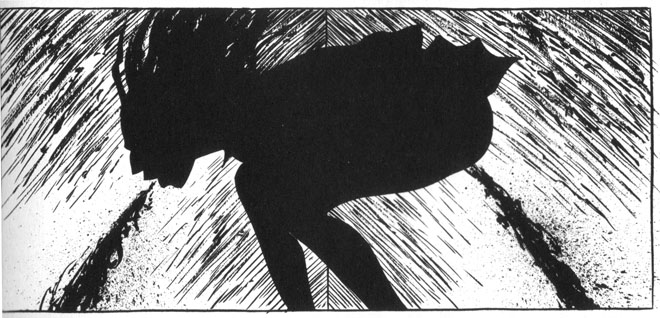
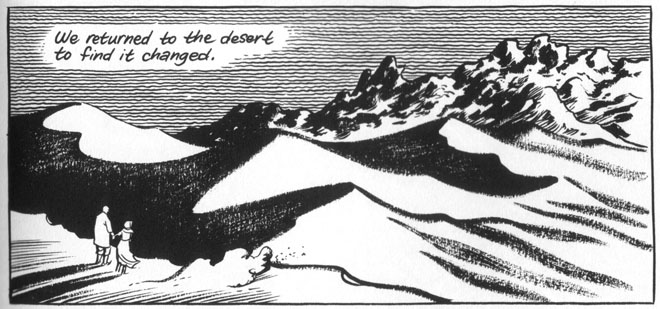
Everything is the same graceful brushstroke, as if that were the main point. The effect is strangely antiseptic in a work that concerns itself so intently with filth and pollution — its mountains of garbage seem designed to wow us more than anything else.
Also, Thompson’s depiction of the great modern metropolis of Wanatolia is bereft of the grimy presence he describes elsewhere, a lifeless construction, all unpacked from the same box: one might argue that this carries a conceptual point about the barrenness of Empire, but it still fails to evoke the environment our heroes will be moving through for the rest of the chapter. Blandness also requires suggestiveness to be recognized as such.
At the risk of repeating myself, my overarching point about comics criticism here is that if one wishes to criticize Habibi’s writing and subject matter, it seems a missed opportunity not to recognize that the problems identified inhere as much in the visuals as in anything else. Merely to describe the art as ‘beautiful’ and otherwise ignore its importance to the work is ultimately doing Thompson — and more fundamentally the comics form itself — a disservice.
Thompson’s deadening control of line and resort to stereotype are part and parcel of the deliberation he brings to his writing and conceptual presentation: everything is there for a reason and he makes sure we know it, even if we sometimes wonder whether that reason is particularly well digested. And in a way you cannot but admire Thompson for his ambition and efforts — Habibi is a smorgasbord of ideas, generously laid out for the reader by a highly talented cartoonist whose enthusiasm is certainly infectious but also, and ultimately, smothering.
Where the work really shines for me is in the passages marked less by overt intent and more by instinct, which was also the case in his previous, autobiographical book, Blankets, in which the uneasy and tentative, if also undeveloped, treatment of the author’s relationship with his brother was by far the most compelling aspect of the story. In Habibi, this unease is primarily located in the treatment of sexual anxiety and transgression, which borders on the obsessive and even the sadistic. It is almost as if Thompson enjoys torturing his characters, especially through sexual humiliation, in a way that suggests meaning beyond the narrative itself.
In Blankets the same themes were treated much more timidly; here, there is a fascinating excess on display. This ties in to the very masculine display of Thompson’s brushwork — executed in what he has described as the “virile” tradition of Blutch and other European cartoonists, from Edmond Baudoin to Christophe Blain (more on that here) — and for which he has employed the tired metaphor of the mark as divine seed more than once, including at the beginning of Habibi. Importantly, it also energizes nervously Thompson’s patently male gaze. A more mature exploration of this tension — a tension fully worthy of his talent and aspiration — would seem to me a fruitful direction for his future work.
__________________
Editor’s Note: This is part of an occasional roundtable on Orientalism and Habibi.
Update by Noah: I try to respond to some of Matthias’ points here.




